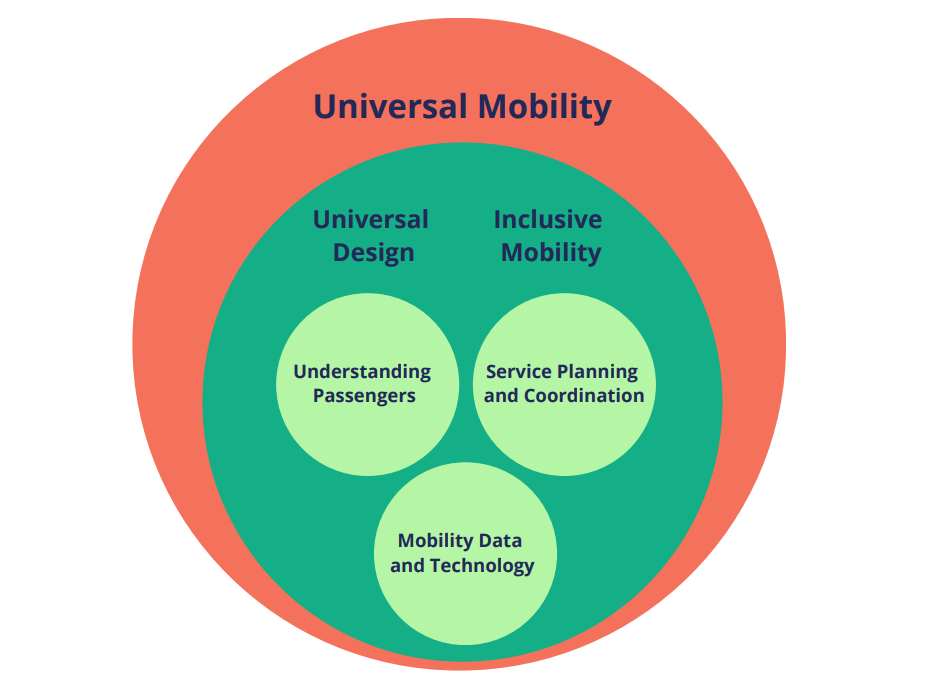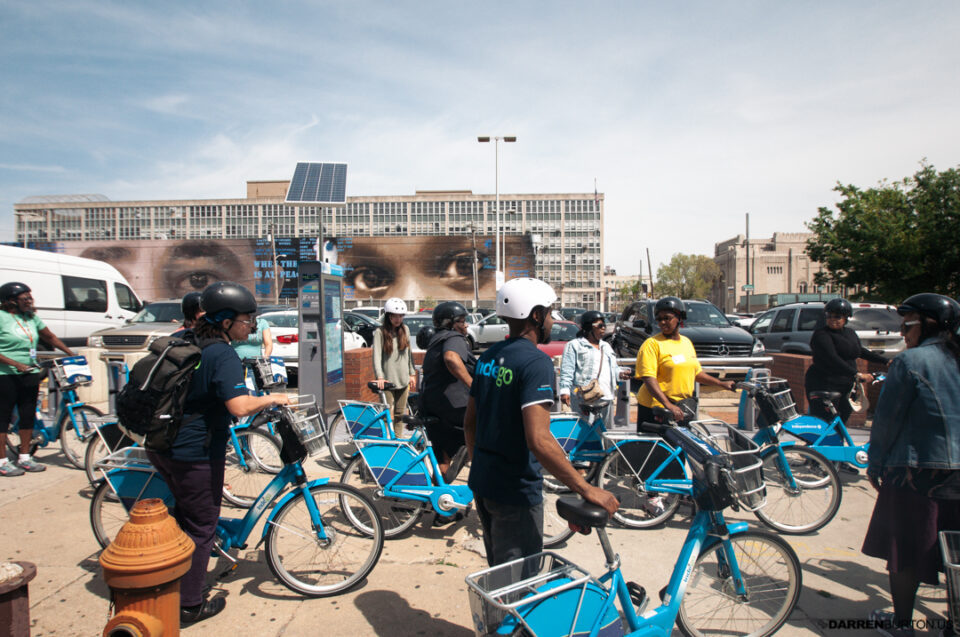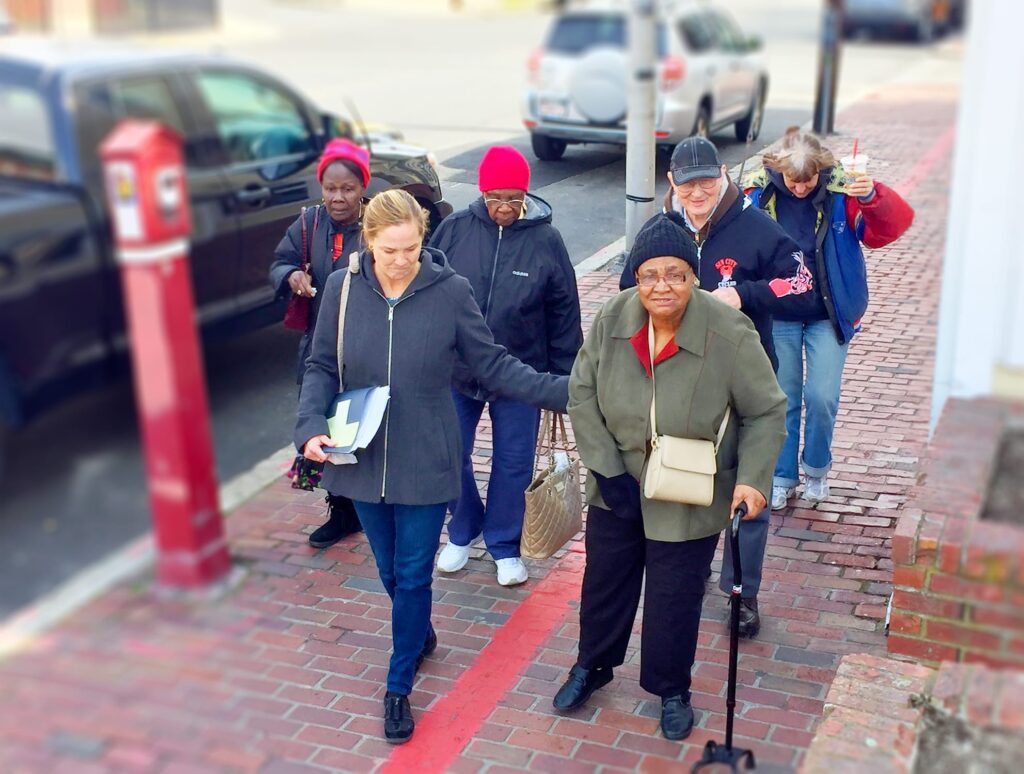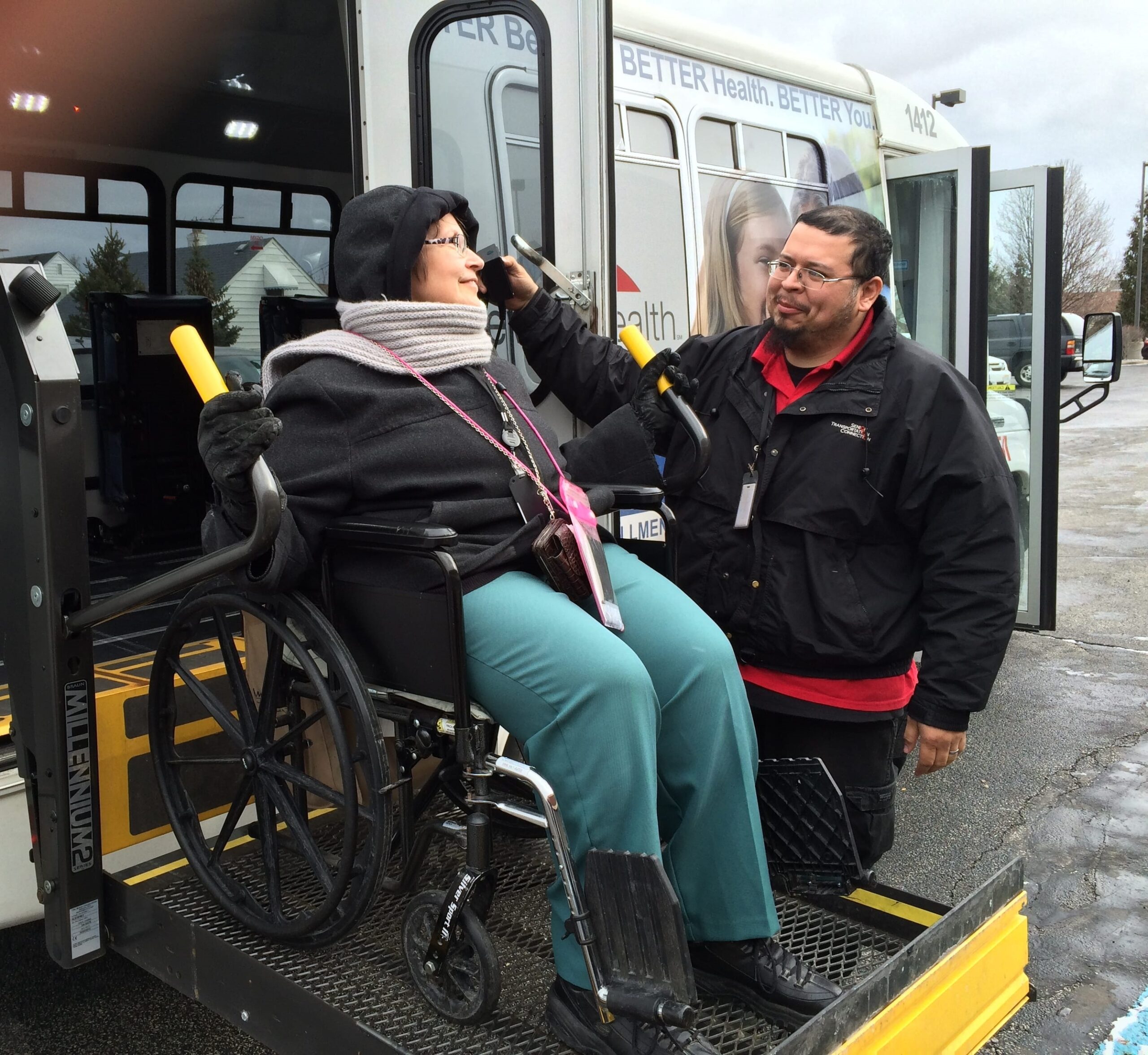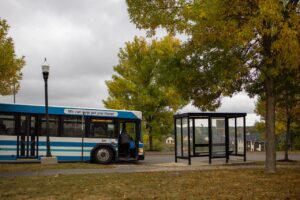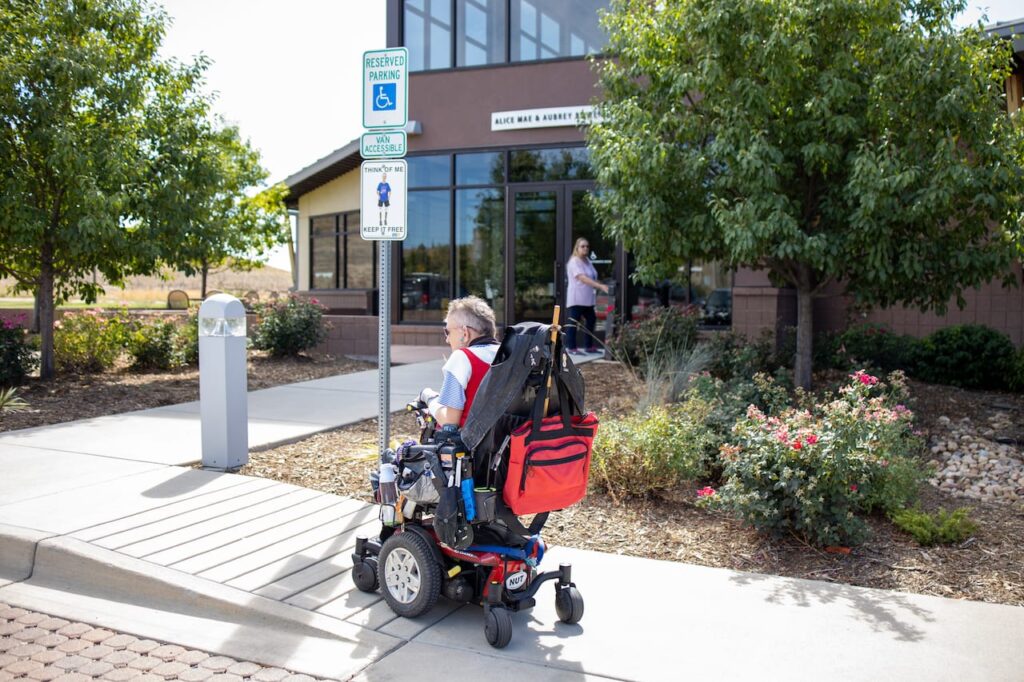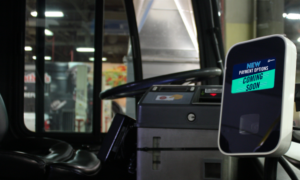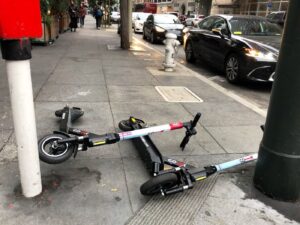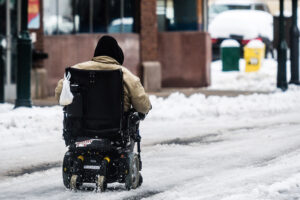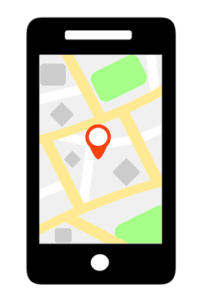Mobility Data
Understanding Mobility Data
A well-functioning mobility system requires understanding how mobility services operate in real-time and assurance that mobility service and accessibility information is available to the public. This is where mobility data comes into play. However, not all mobility data’s use and implications are the same. For example, data that are available through private operator systems are often specific to that mobility operator, making communication difficult across agencies and other mobility services. On the other hand, the focus of this section is the applications of open data and the role it plays in promoting mobility interoperability. The Mobility Data Interoperability Principles (MDIP) offers a good definition for open data and mobility data interoperability.
- Open Data Standard is a specific ontology, schema, or format used by the mobility industry to facilitate consistent communication between devices. A commonly used open data format is GTFS, which allows for the discoverability of transit services and is open and available to the public.
- Mobility interoperability is defined as the ability of any mobility technology component to exchange data in an open standard or schema with other components in that mobility technology system.
When in place, mobility data helps cities enforce transportation regulations and modify existing regulations to ensure the smooth functioning of transportation services. It also provides a wide range of insights on usage patterns and travel needs which can be leveraged to improve the planning and operations of mobility systems. Interoperable mobility data can also help integrate services across multiple modes or providers of the same mode (e.g., DRT), increasing mobility access and alleviating duplicative services. Subsequently, communicating real-time mobility data to the public can make it easier for people to move around urban and rural spaces. These benefits are far-reaching, impacting all mobility users, including persons with disabilities and older adults.
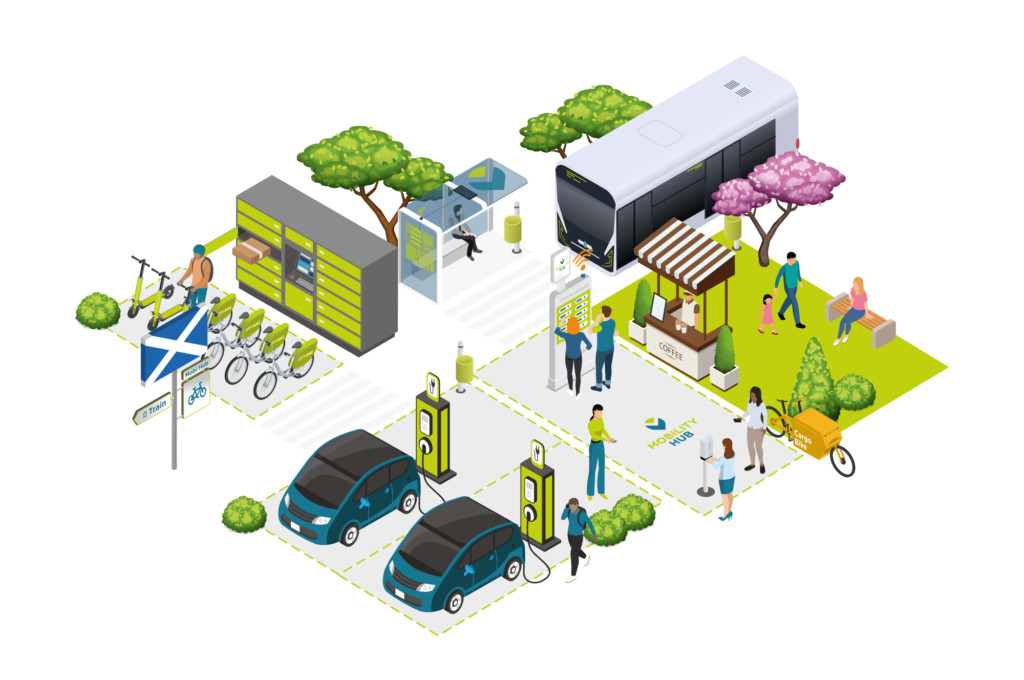
Mobility Hub demonstrating multi-modal system, including carshare, bikeshare, transit, pedestrian amenities, wayfinding, and transit | Source: ComoUK
Building Understanding and Capacity
For agencies to use mobility data, they must first understand what it is and its implications. Smaller agencies, or those with limited budgets, can look toward larger governing agencies to help support these efforts. For example, the Minnesota Department of Transportation (MnDOT) was awarded an FTA Accelerating Innovation in Mobility (AIM) grant from the Federal Transit Administration (FTA) to build a regional Mobility as a Service (MaaS) platform. MnDOT worked with many of the smaller rural agencies in the service area to help develop their understanding and capacity for using mobility data and avoid creating an undue burden on those communities.
Having data management systems in place and understanding mobility assets and challenges enables agencies to take on more complex technology-driven solutions. While data can be leveraged to create more accessible transportation systems, mobility providers must have the ability to share data across multiple platforms and tools. Open data helps to promote this communication and interoperability across mobility systems. When in place, these interoperable systems enable transit providers to plan services responsive to rider needs and can help to improve service quality and efficiency.
Mobility Data Applications
Following are some example issues that surfaced during the working group discussions and the role that mobility data can play toward promoting universal mobility. For more information on these data specifications and others, see The Role of Data Specifications in Creating an Interoperable Transportation System case study.
- Where are sidewalks available, and are there impediments? Both the presence and quality of sidewalks are critical to the complete trip. A bus or rail station that is accessible is only a part of a person’s trip and cannot fully be considered accessible if there are no clear paths for people to access those mobility services. Two data specifications help to address this issue as they outline criteria to manage curb space and other sidewalk-related information; CurbLR and Curb Data Specification (CDS). CurbLR communicates curb-use regulations from local governments to mobility, delivery, and freight services and the broader public. CDS also provides a formula for sharing regulations between local governments, mobility, delivery, freight services, and the wider public.
- How do I identify where e-scooters and other shared modes block sidewalk access? The Mobility Data Specification (MDS) outlines how cities and private mobility providers, like micromobility operators, communicate information, while CurbLR and the Curb Data Specification (CDS) help cities communicate curb regulations.
- Service capacity constraints limit our agency’s ability to provide service. While under development, the Transactional Data Specification (TDS) is a backend tool that enables coordination/interoperability among providers once the user requests a booking. The Operational Data Standard (ODS), a new standard, outlines how transit agencies can relay information areas like non-revenue service and personnel.
- What mobility services are available for me to plan a trip? GTFS and some of its extensions, including GTFS-Flex and the General Bikeshare Feed Specification (GBFS), are known as “discovery specifications” because they help transportation users learn about what mobility services are available to them at a given period.
- What mobility services are available to support my first-last mile connections? GTFS-Flex adds the capability to model various demand-responsive transportation (DRT) services to GTFS, which currently only models fixed-route public transportation and GBFS is available for micromobility services. Micromobility services, like scootershare and bikeshare, rideshare, and microtransit services have discovery specifications designed uniquely to help users discover their respective services.
- How can human service transportation providers serve the community, and how might one qualify to use these services? There are two specific GTFS extensions: Capabilities and Eligibilities. Many human service transportation providers offer service characteristics tailored to specific rider groups or they may require passengers to meet specific eligibility requirements. These Capabilities and Eligibilities extensions help them communicate more specific parameters of this nature to their customers.
The world of mobility data is like a set of building blocks. It is important that people understand and are comfortable with mobility solutions. Ensuring people understand the implications of technology-driven solutions and how those solutions can further the goal of mobility interoperability and universal mobility. Using mobility data does not occur in a vacuum and must align with the other Elements discussed in this Learning Module. For example, implementing any data specifications noted above without understanding user mobility needs and current mobility services will likely not create the on-the-ground support needed for implementation and adoption by the communities. More complex mobility data specifications require greater interagency coordination and community involvement.
Challenges
Mobility data can promote universal mobility by addressing challenges around discovery, access, and management of shared mobility and supporting infrastructure. Here are some of the challenges that surfaced during our discussions with the Universal Mobility Working Group around how to use mobility data and what specific issues it can help to address.
- Partner agencies do not understand the value, uses, and ownership of data to enable multi-modal data platforms to create data silos. As a result, data may not be available when and where they are needed, either because people are unaware of them or they are in an incompatible format.
- Agreed-upon frameworks are essential for communicating transportation data and creating interoperable systems. Transit agencies may not be able to access private mobility data that could help them better understand the mobility landscape in their communities and target their services to meet user needs.
- Some private mobility operators have been hesitant to share data due to concerns about privacy, public records requests, and competition.
- As discussed in the service and planning coordination element, micromobility sidewalk clutter and insufficient ways of managing usage can present significant issues for persons with disabilities. While there is a coordination aspect to it, the regulatory and enforcement can be assisted with the MDS data specification. By using MDS, agencies can manage micromobility operations from a planning perspective.
- The Transactional Data Specification (TDS) is a backend tool that enables coordination/interoperability among providers once the user requests a booking. It is currently being piloted or planned in several communities across the U.S., ranging from rural applications to urban settings. The TDS implementation is challenging for a number of reasons, such as the limited awareness among transit operators on its applications, the limited support from private mobility operators to adopt the TDS, and differing rider eligibility criteria among mobility services – making it difficult to coordinate trips across multiple agencies.
- An accessible transit station is not accessible if the sidewalk and other paths are missing or in disrepair. This challenge is amplified as trip planning platforms rarely offer information on the station, stop, sidewalk, or street conditions.
- It is challenging to have a meaningful discussion on service access if agencies don’t have access to site location and usage data.
Recommendations
Mobility data will not solve all of the impediments to realizing universal mobility. However, it can help address issues around the discoverability of services, accessing those services, and managing supporting infrastructure. The communication that open mobility data promotes across mobility platforms helps to create an interoperable mobility system that better meets the needs of all of its users. Here are some recommendations to promote mobility interoperability and further universal mobility.
- Agencies should invest in training existing personnel and hire additional personnel to manage IT if needed.
- Smaller agencies with limited budgets can look for support from neighboring agencies or larger oversight agencies that may have additional resources to help understand and apply mobility data. DOTs and regional MPOs are a good starting point as they can provide tools and resources to smaller agencies, particularly in rural areas.
- Building support and awareness among regional mobility operators through working groups and other convening opportunities is one of the first steps to a successful open mobility data solution. These opportunities allow neighboring transit agencies and other mobility operators to share experiences, discuss challenges, and learn about opportunities to implement data solutions to improve the discovery and coordination of mobility services.
- Develop data-sharing requirements for public-private partnerships:
- Convene with peer agencies who have established public-private partnerships to get a better idea of the considerations and challenges they have experienced regarding access to data and to understand what data are most important to a pilot’s success.
- Agencies should also use broad language when defining their use rights in data-sharing license agreements with mobility providers to allow flexibility and avoid contract renegotiation.
- Ensure the right to share data with other public sector entities, such as DOTs or MPOs, that have a role in planning, right-of-way management, and service coordination.
- Prioritize mobility providers who use open-source data standards like the General Transit Feed Specification (GTFS), the General Bikeshare Feed Specification (GBFS), the Transactional Data Specification (TDS), or the Mobility Data Specification (MDS).
- Encourage the use of data standards and specifications to support the exchange of mobility data and interoperability between systems. Agencies can leverage technology to communicate trip planning information to travelers better. First and last-mile connections to transportation services are vital, and users should have a convenient way to access up-to-date information on accessibility conditions. DRT providers can interoperate their services to reduce service redundancy and increase the opportunity to book a trip. Before implementing an integration solution(s), make sure to consider the following:
-
- What type of data needs to be integrated?
- Which applications need to be integrated, and how?
- How data will flow within and outside of an agency?
- How to implement open standards and specifications?
- What policies can be introduced to encourage vehicle sharing, shared funding, and accountability mechanisms that reward entities for creating continuums?
- How to document promising practices and guidelines around mobility data interoperability?
- Understand that mobility data applications do not occur in a vacuum. The Service and Planning Coordination Element and other Elements discussed in this module are critical for adopting mobility data solutions.
Resources
- The Role of Data Specifications in Creating an Interoperable Transportation System: This resource provides an overview of the role and applications of open data. The case study offers a summary table of some of the most commonly used data specifications.
- White Paper: Objective-Driven Data Sharing for Transit Agencies in Mobility Partnerships: This resource can help transit agencies determine the right data-sharing approach for their project and consider the benefits and trade-offs of various options. It details current data-sharing practices and real-world scenarios, aiming to guide agencies in establishing mobility partnerships with local operators.
- A Practical City Guide to Mobility Data Licensing: This resource can help aid entities as they craft their data-sharing rules and negotiate with mobility providers.
- CPACS Ride – Lessons Learned in Four Phases – Phase 2: Procurement: This resource highlights the Center for Pan Asian Community Services (CPACS) experience planning and executing software procurement to support their CPACS Ride microtransit project.
- National RTAP’s GTFS Builder: This website offers several resources to understand how to use GTFS and build GTFS data files.
- SUMC MLC: Mobility Learning Center: Mobility Data Specification: A Data Standard for Shared Mobility Providers, Los Angeles, California, 2018 (sharedusemobilitycenter.org); This resource provides information about the Mobility Data Specification (MDS), a tool developed by the Los Angeles Department of Transportation (LA DOT) to manage shared mobility providers. The open specification allows for two-way communication between service providers and the jurisdictions in which they operate. LA DOT plans to expand it to include other shared modes such as carsharing and ridesharing. The article also discusses some of the data that is shared through the MDS and the intended audience for the specification. This information may be helpful for anyone interested in understanding how LA DOT is managing shared mobility providers and the data they generate.
- SUMC MLC: Mobility Learning Center: Open Mobility Foundation Releases Candidate for New Curb Data Specification (CDS), 2022 (sharedusemobilitycenter.org); CDS specifies how cities and curb users, like taxi and delivery companies, share curb regulations and exchange data. This new specification consists of three application programming interfaces (APIs): the Curbs API, the Events API, and Metrics API.
- SUMC MLC: Mobility Learning Center: State Agency Releases Operational Data Standard, CA, 2022 (sharedusemobilitycenter.org); The Operational Data Standard is a new standard that outlines how agencies can provide community information like personnel and non-revenue service.
- Mobility Data Interoperability Principles (MDIP); MDIP offers several open data and mobility interoperability resources, including a helpful glossary of the most common terms.
- Modernizing Demand-Responsive Transportation for the Age of New Mobility; This resource discusses Transactional Data Specification and its role in helping increase mobility access specific to older adults and persons with disabilities.
Next Subsection
Technology
New technologies and mobility data-driven solutions are continually emerging. Within the last decade, smartphone technology advancements have led to mobility-on-demand solutions that were not previously possible. While these technological solutions are important, they are a piece of the more extensive mobility system that needs to work together. Even more critical, these technology solutions are not always applied to projects with the end user in mind and thus are not sensitive to their personal or cultural means. Technology makes it possible to, among other things, diversify transportation options, offer new services, plan for the complete trip, and obtain/share user data. Still, these technology applications should consider the end user and strive to improve the customer experience. Technology solutions implemented without this understanding often sit idle, given the limited interagency support and misperceptions from the community they aim to serve.
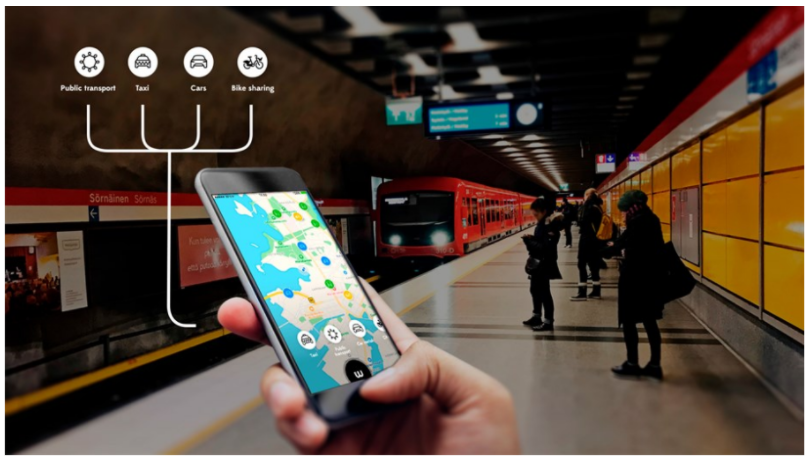
Example of mobility as a service app. Source: SUMC
There are good examples of where technology has been implemented with the transit user in mind, and these examples demonstrate that this needs to be a deliberate process that is budgeted and planned. Understanding the mobility users’ needs extend to the tools themselves, such as the app used to find and book services and assuring that there are multiple ways to access the technology solutions. Meaningful community engagement takes time. Equally important, and similar to the Universal Design Element, when technology solutions are developed in a vacuum, the costs associated with retrofitting them to accommodate all users after the fact can often exceed the costs if they were developed with input from the community throughout the process. When the community is involved in this effort and the needs of all individuals are considered, then the end product, whether it be a mobility service or a mobility app, works better for all users.
Hopelink, a Seattle-based social service non-profit, is developing a One-Call/One-Click mobility services platform centered on a planning process in partnership with the King County Mobility Coalition (KCMC). Any individual needing a trip within the boundaries of One-Call/One-Click can access and use its platform at no cost. In the near term, data specifications will include the General Transit Feed Specification (GTFS) and GTFS-Flex; later on, KCMC might also integrate the General On-Demand Feed Specification (GOFS), GTFS-Eligibilities, and GTFS-Capabilities. These discovery specifications can help customers identify information about available transportation services, such as schedules, fares, seating, and accessibility features. In the future, the Transactional Data Specification (TDS), under development, could allow interoperability among providers so when the rider requests to book a trip with one provider they are actually tapping the resources of other providers within the system.
Move PGH began in July 2021 to integrate public transportation with other shared mobility services like carshare, scootershare, and bikeshare. The Department of Mobility and Infrastructure has developed this program in partnership with different technology vendors, like Spin and the Transit app. Move PGH seeks to create a mobility-as-a-service (MaaS) experience for people across Pittsburgh by:
- Making transit services and different modes of shared mobility discoverable through the Transit app. This adds a new element to trip planning as users can get a more holistic view of different transportation options.
- Creating dozens of Mobility Hubs where public transportation and shared mobility services are co-located. The City of Pittsburgh hopes this creates an environment where shared mobility becomes a more viable and appealing option to residents and visitors.
- Piloting a Guaranteed Basic Mobility (GBM) program for 50 low-income residents. In the GBM pilot, users have one year of free access to the mobility offerings in Move PGH.
Challenges
Community engagement is also discussed in the Understanding Passengers Element, but below are some specific challenges related to planning and implementing technology and mobility data solutions.
- Agencies can face difficulties engaging the transit user and building trust with the community.
- Services are not always evenly distributed available throughout a city and to persons with disabilities.
- There may be a misperception that it costs more to involve the community in the planning process.
- Applications and end user tools are not built with all user requirements in mind.
- The impact that technology can have on promoting access to transportation not always apparent.
- Transit agencies are often behind on technology adoption. With transportation innovation tied to technology, agencies will require training and perhaps new personnel to manage these incoming initiatives.
- The transportation sector is constantly evolving. New technologies are emerging to drive innovation, increase operational and service efficiencies, user safety, and convenience. However, the pace in which technology advancement is occurring makes it difficult for agencies, especially those without as many resources, to fully understand their capabilities and application. Certain agencies may also lack the funds to adopt and maintain the infrastructure required for these technology applications.
Recommendations
There are many resources on how to hold meaningful community engagement, including those highlighted below and the resources listed in our Understanding Passengers Element. These strategies can be effective and should be practiced from the beginning of a project and throughout its implementation. Following are the recommendations we heard from our targeted discussions with the Universal Mobility Working Group specific to the use of technology. Still, these recommendations should be considered within a larger community engagement plan.
- Budget for meaningful community engagement and input from transit users. Build meaningful partnerships with community groups to better reach mobility users. Recognize that people’s time is valuable in these efforts and offer financial support for their time and expertise.
- Regularly follow up and communicate project progress with those who offered their time and shared their knowledge during engagement efforts.
- Engage people with disabilities from the beginning of a project and throughout its implementation to ensure the technology and mobility data solution meet their needs.
- Pilot projects and mobile apps with a small group of people first create a mechanism for obtaining feedback and reporting back to the community regularly. Doing so is critical, given mobility access changes directly impact a person’s ability to travel. Technology solutions will require time to implement and fully understand what unintended consequences they may have on the more extensive mobility system.
- Agencies should work closely with their technology provider(s) and advocate for improvements to address transit user needs. Community engagement and understanding passengers are critical to learning about traveler needs and how mobility services impact their daily lives.
- When piloting a technology, make sure there is a process for drivers to offer feedback and create a dialogue with the operations team to understand how planning decisions might impact riders.
- Provide trip planning support information, including information on transportation services available and accessibility conditions, to travelers for their trip.
- Incorporate accessibility information into trip planning platforms or applications.
- Establish a crowdsourcing app where the public can provide information on current accessibility barriers throughout the system.
- Initiatives that incorporate participatory data collection have become more prevalent over the years. In recent years the National Science Foundation funded Project Sidewalk, a web-based crowdsourcing platform where users can label in-accessible sidewalks in some North American cities, including Seattle.
- Develop a database of infrastructure obstacles and safety.
Resources
Listed are resources offering strategies to hold meaningful community engagement specific to planning and launching technology and mobility data solutions.
Previous Subsection Next Subsection
Checklist
Understanding Mobility Data
Agencies should understand what potential providers’ approaches to data sharing are and aim to select a partner that aligns with their needs.
- Do you have a data-sharing agreement in place ahead of launching a new service/project?
- Do you use the same data sharing licensing format for each mobility provider you work with?
- What is your staff capacity to understand and implement open data solutions?
- Are there partner agencies that have experience with similar questions and challenges?
- Are there overarching agencies that provide support and resources on open mobility solutions?
- Are there opportunities to implement open data solutions to help address particular challenges and mobility needs?
Technology
While technology is often presented as the solution to streamline efficiencies or improve the customer experience, stakeholders and project managers should think about the real-life implications technological solutions may have on an individual’s ability to access essential services or participate in project-related engagement efforts.
- What can the organization now achieve by introducing this technology?
- Were community residents engaged in the planning process prior to a technology solution being implemented?
- Does your project consider unbanked users?
- Is the use of technology assisting in meeting goals related to customer experience?
- Do you have metrics in place to measure customer experience?
Offering information on the station, stop, sidewalk, or street conditions plays a large role in an individual’s ability to access shared services like transit. Technology can be leveraged to ensure that real-time accessibility information is readily available to travelers.
- Are trip planning applications available in your planning area?
- How is traveler information (i.e, delays, incidents, weather-related messages, travel times, emergency alerts) relayed to users and passengers?
- Do the trip planning applications available in your area obtain accessibility condition information that is pertinent to people both with and without disabilities?
Whether the functions needed to run a successful pilot service are performed in house or contracted out, it is important that agencies are prepared to overcome operational and service issues that stem from incorporating technology based solutions. While it’s become common for transit agencies to partner with transportation technology companies when launching a new on-demand microtransit service, these companies are constantly in flux.
- Does your agency have the staff capacity, knowledge, and funding to adopt, maintain, and operate the infrastructure needed to pursue mobility software solutions?
- Do you have processes in place to keep your mobility services up and running when software vendors have outages?
Previous Subsection









